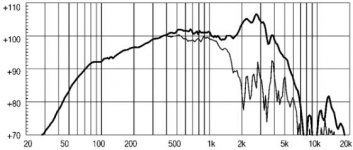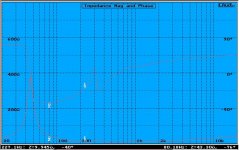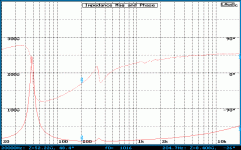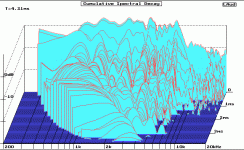Hi,
I'm looking for a 12" driver to use with my 140hz tractrix horns. There are lots of good options, and I have settled on the 18sound 12MB700 for now. The only issue I can see is the 5-8dB peak between 1,8-3,2 khz. This would not be an issue if I used DSP, but I would like to make a passive crossover and as simple as possible. Would it be futile to consider a 1st order LP crossover at say 400hz for this driver?
I'm looking for a 12" driver to use with my 140hz tractrix horns. There are lots of good options, and I have settled on the 18sound 12MB700 for now. The only issue I can see is the 5-8dB peak between 1,8-3,2 khz. This would not be an issue if I used DSP, but I would like to make a passive crossover and as simple as possible. Would it be futile to consider a 1st order LP crossover at say 400hz for this driver?
Attachments
Yes, that would indeed be futile. Even if it would work with perfectly shaped slopes with a 6dB crossover (which it evidently does not) and ignoring or filtering the resonances, the HF part gets way too much power below the xo point, that means it could easily fry and distort very early because it's leaving the linear excursion. For the woofer you can expect a lot of resonance ridges higher up.
Or short: No, that doesn't work. Use (much) steeper filters.
Or short: No, that doesn't work. Use (much) steeper filters.
I also think you will have distortion and possible damage at 400 hz. Why no do the crossover as well using DSP?
Thanks for your input ICG, you confirm what I was really expecting.
Problem is finding a driver with the right specs for horn loading and also without this frequency peak (cone breakup?). Most low QTS 12" pro drivers have this unfortunately..
I'm not sure I follow you here, why do you think there would be distortion and possible damage at 400hz?
As for DSP, that would be the logical choice, I know. I will start the design phase using DSP to find the best XO frequencies and slopes. Then I would like to attempt a passive crossover build. Because I want to use only one really good SET amp from 150hz and up (3-way horn), and DSP amp for bass. I know it will be a challenge with level and impedance matching and so on.
Problem is finding a driver with the right specs for horn loading and also without this frequency peak (cone breakup?). Most low QTS 12" pro drivers have this unfortunately..
I also think you will have distortion and possible damage at 400 hz. Why no do the crossover as well using DSP?
I'm not sure I follow you here, why do you think there would be distortion and possible damage at 400hz?
As for DSP, that would be the logical choice, I know. I will start the design phase using DSP to find the best XO frequencies and slopes. Then I would like to attempt a passive crossover build. Because I want to use only one really good SET amp from 150hz and up (3-way horn), and DSP amp for bass. I know it will be a challenge with level and impedance matching and so on.
If you are trying to horn load your 12" driver, you should be able to come up with a horn that rolls off the high frequencies acoustically. I was playing with a 6pev13 and had about 24 dB per octave roll off after 1 kHz. I will run a simulation before inserting my foot any deeper. 🙂
If you are trying to horn load your 12" driver, you should be able to come up with a horn that rolls off the high frequencies acoustically. I was playing with a 6pev13 and had about 24 dB per octave roll off after 1 kHz. I will run a simulation before inserting my foot any deeper. 🙂
Hi Doug,
that is exactly what I have been thinking, taking advantage of the acoustical low pass filter effect of the throat chamber between driver and horn. I just don't know if it is enough to tame the peak.. Guess I will just have to buy the drivers and do some testing 🙂 How large did you make the throat chamber for the B&C driver?
For the 6PEV13 I had it set to 100 CC. I think the low BL and mass was killing it.
For the 12MB700, I tried 4000 cc with Atc = 523 and got an 18 dB per octave roll off @ 1 kHz with a 200 cm2 throat.
It was down about 30 db @ 1.8k with a 6 db per octave filter added in and dropping @ 24 db per octave (filter plus acoustic roll off).
Let us know what you find.
For the 12MB700, I tried 4000 cc with Atc = 523 and got an 18 dB per octave roll off @ 1 kHz with a 200 cm2 throat.
It was down about 30 db @ 1.8k with a 6 db per octave filter added in and dropping @ 24 db per octave (filter plus acoustic roll off).
Let us know what you find.
Thanks for your input ICG, you confirm what I was really expecting.
Problem is finding a driver with the right specs for horn loading and also without this frequency peak (cone breakup?). Most low QTS 12" pro drivers have this unfortunately..
If they don't have this, they are most of the time not that great in the midrange. I don't understand though why you don't use steeper filters.
As for DSP, that would be the logical choice, I know. I will start the design phase using DSP to find the best XO frequencies and slopes. Then I would like to attempt a passive crossover build.
Uhm, that doesn't work that way. You might find a perfect XO at a certain frequency but it isn't possible to re-create that filter because it hugely interacts with the impedance and don't show the reaction and slopes of the dsp setting AT ALL. That works for some drivers (i.e. some AMTs or ribbons) because they have a flat response and impedance aswell but the impedance response of horn speakers is a rollercoaster. You'd be forced to smash the impedance nearly completely flat with several suction filters, which will drag your spl aswell the impedance down and you'll sink a ton of money into the parts. Definitely not worth it. Finding the best compromise passive for the filters and the XO is a process which goes hand in hand and can't be separated that way.
If you are trying to horn load your 12" driver, you should be able to come up with a horn that rolls off the high frequencies acoustically.
The goal isn't to have a rolloff at a certain frequency, the goal is to tame the resonances while maintaining the same dispersion pattern and a good decay time. Most horns doesn't do two, not to speak of all three. And especally not if it has to play at a that wide frequency range. And if they do, they often need a lot of EQing.
It is natural for a 12" driver to want to breakup in this higher region. You can use a passive filter. 6dB doesn't match the peak..
I am admittedly a horn novice.
Can you expand on your thoughts?
My thinking in simple terms is that the front chamber of a horn forms a low pass filter.
Driver resonances and distortion above the acoustic low pass will be filtered out.
The horn I modeled was low compression, covered less than a decade (150 Hz to 1 KHz) before electrical filters and seemed reasonably well behaved. Group delay below 200 Hz was ridiculous and the horn was huge (83 L).
Can you expand on your thoughts?
My thinking in simple terms is that the front chamber of a horn forms a low pass filter.
Driver resonances and distortion above the acoustic low pass will be filtered out.
The horn I modeled was low compression, covered less than a decade (150 Hz to 1 KHz) before electrical filters and seemed reasonably well behaved. Group delay below 200 Hz was ridiculous and the horn was huge (83 L).
My thinking in simple terms is that the front chamber of a horn forms a low pass filter.
It is.
Driver resonances and distortion above the acoustic low pass will be filtered out.
Uhm, no. That doesn't chop the response straight down. The peaks will still show, about ~10-14dB lower. Which makes them almost equal in loudness as the actually used/wanted frequency range.
The horn I modeled was low compression, covered less than a decade (150 Hz to 1 KHz) before electrical filters and seemed reasonably well behaved. Group delay below 200 Hz was ridiculous and the horn was huge (83 L).
Do you realize the resonances are much louder than the used frequency range? Your model/simulation does not account for the cone breakup nor the resonances on top and neither for the decay delay and distortion. You'll have 'nice' mountain ridges in your decay waterfall.
Thanks for the response.
To summarize, The combined driver / horn response is not rolled off sufficiently with the proposed electrical and acoustic filters to correct the driver in the cone breakup region.
To summarize, The combined driver / horn response is not rolled off sufficiently with the proposed electrical and acoustic filters to correct the driver in the cone breakup region.
Yes. It is the same for the most other drivers too, maybe with lower resonance peaks but the 1st order filter is not appropriate for this setup (or the most other horn setups).
Yes. It is the same for the most other drivers too, maybe with lower resonance peaks but the 1st order filter is not appropriate for this setup (or the most other horn setups).
Thank you all very much for your responses, I appreciate your input!
I realize I have alot to learn about passive crossovers, I am definitely a newbie on this subject.
ICG, do you have first hand experience with the combination of acoustical and electrical filters? When DougL says that the combination produces a combined rolloff of 24dB/oct, that sounds like alot to me. Consider this rolloff starting at 4-500hz, that would be down 48dB around the cone breakup frequency. Not sure where the actual acoustical rolloff would start with the 12MB700, guess it depends on the volume of the throat chamber..
To clarify, this driver/horn combination will only cover from 150hz to 500hz.
And ICG you asked about the reson for not using DSP, please see my post #4 where I explained this.
ICG, do you have first hand experience with the combination of acoustical and electrical filters?
Yes.
When DougL says that the combination produces a combined rolloff of 24dB/oct, that sounds like alot to me. Consider this rolloff starting at 4-500hz, that would be down 48dB around the cone breakup frequency. Not sure where the actual acoustical rolloff would start with the 12MB700, guess it depends on the volume of the throat chamber..
That pretty much depends on the compression chamber size and geometry. Unlinearities and resonances not only come the driver/cone but also from compression, losses and across and length resonances of the horn. The acoustical slope can be very different because of the driver response, resonances, reflections in the horn, sharp edges (diffraction) or non-ideal horn (which is often found in such horns). I don't know what he assumed as electrical filter, the low pass effect of the compression chamber is generally around 6dB/oct though.
To clarify, this driver/horn combination will only cover from 150hz to 500hz.
I forgot about that but that doesn't change much. Not all resonances are showing up as a peak, some bring distortion or very delayed decay with it or even all of it. The response plot looks like the cone breakup (or at least resonances) are starting already at below 1kHz, since the angle measurement drops and rises again which indicates only a part of the membrane is radiating the sound there (smaller moving surface = wider dispersion). That is an assumption though, it might also be partitial resonances or a resonance of the surround. The impedance plot could probably show it. But generally, the response in the horn will be a lot different than the manufacturer response graph. But let's assume 500Hz xo and 'just' the 2k+ peaks. From 500-2000Hz that are 2 octaves, -6dB from the crossover and -6dB from the compression chamber x2 (2 oct) are 24dB. The peak is ~8dB, so 24-8=16dB. That means, the resonances are just 16dB lower than the used range. That's still significant, so you have either to introduce a suction circuit there or to use a much steeper filter (or both).
And ICG you asked about the reson for not using DSP, please see my post #4 where I explained this.
Well, I overlooked that, sorry for that. The filter of the dsp works a lot different than the passive crossover because the passive will interact with the impedance, which, in a horn, is practically a roller coaster. You could do an impedance compensation but that would introduce a lot of additional parts and would drag down the impedance and spl. The result is, your slopes will look a lot different and you'd have to change a lot in the crossover, which also affects the phase. It often happens you cannot use the same filter topology at all, which means you have to restart from zero.
If you want to use a passive crossover at the bottom, you'll have very likely to fight the impedance peak of the driver, meaning you'd have to drag it down for the filter to work correctly. The parts will be very expensive and the LP filter for the bass will also introduce serial resistances which increase the Qt a lot, and you have no influence at the phase at all, so that's not really a good choice. You can expect the parts cost to be well above to a multiple the cost of a dsp. You should at least consider a partly acitve setup in the bass as it will not only be cheaper but also much better in sound quality.
This is nonsense. The result will be completely correct if done correctly.You could do an impedance compensation but that would introduce a lot of additional parts and would drag down the impedance and spl. The result is, your slopes will look a lot different and you'd have to change a lot in the crossover, which also affects the phase.
This is nonsense. The result will be completely correct if done correctly.
There are numerous examples which can't be done 'correctly' within the certain given parameters passive without sinking a goldmine into the crossover network but work fine with a dsp, namely if the woofer/subwoofer is crossed over at a low frequency and the resonance peak messes massively with your passive filters. This is an example.
You are saying that's nonsense? Okay, please show it then.
Cost? There's a lot of arm waving here. Neither active nor passive can be done correctly without skill and procedure.
Seems like I may have to look for a driver with better behaviour than the 12MB700.
I know two very well regarded high-end horn speaker manufacturers from Germany (Cessaro and Hornfabrik) uses the Supravox 285-2000 for this frequency band and with 1st order passive crossover.
This 12" driver does not seem to suffer from cone breakup, or at least much less so than the 12MB700.. The downside is the cost, this is a very expensive driver!
Any other options for 12" drivers that will work well with a simple passive crossover?
Edit: the attached curves are for the Supravox.
I know two very well regarded high-end horn speaker manufacturers from Germany (Cessaro and Hornfabrik) uses the Supravox 285-2000 for this frequency band and with 1st order passive crossover.
This 12" driver does not seem to suffer from cone breakup, or at least much less so than the 12MB700.. The downside is the cost, this is a very expensive driver!
Any other options for 12" drivers that will work well with a simple passive crossover?
Edit: the attached curves are for the Supravox.
Attachments
Last edited:
Seems like I may have to look for a driver with better behaviour than the 12MB700.
I know two very well regarded high-end horn speaker manufacturers from Germany (Cessaro and Hornfabrik) uses the Supravox 285-2000 for this frequency band and with 1st order passive crossover.
Both do not use a compression chamber.
This 12" driver does not seem to suffer from cone breakup, or at least much less so than the 12MB700.. The downside is the cost, this is a very expensive driver!
The driver is built like a fullrange driver. The geometry and thickness of the paper cone changes over the diameter, that makes the cone not instantly break up but more gradually with the frequency. The driver got a lot of disadvantages though.
- Very low power capability (70W) for the size. Because of the spl (and horn) likely not an issue though.
- Very high VAS (154l), Qts (0,64), the back chamber has to be BIG
- High fs (60Hz). Combined with the high VAS and Qts the resonance quickly rises into the horn range, which causes a huge decay ridge.
- Can't get low. Just isn't built for bass, not an issue in a low mid horn though.
- Huge, very serious resonance at 250Hz with distortion
- Very high distortion
- Very serious waterfall decay delay
- The price. Ow.


SUPRAVOX 285 EXC - 11" Mid Bass
The decay gets much worse below 350Hz but the measurement stops above it because of the gating.
That means, yes, you get some (few) very good advantages. But on the other hand, you have to pay for it mercyless. In acoustics, there's no such thing as 'free lunch'.
Attachments
- Status
- Not open for further replies.
- Home
- Loudspeakers
- Multi-Way
- Driver selection for 1st order crossover




